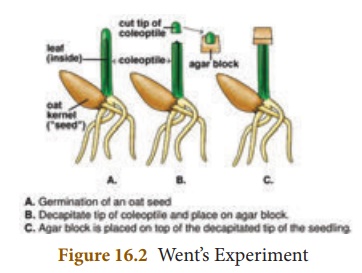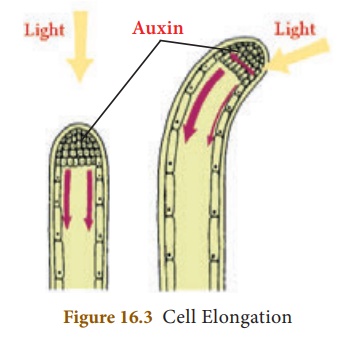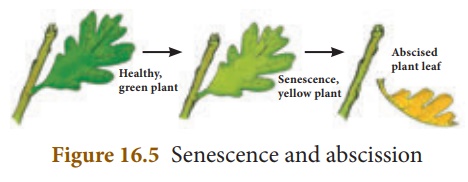Chapter: 10th Science : Chapter 16 : Plant and Animal Hormones
Types of Plant Hormones
Plant Hormones
Plant hormones are organic molecules
that are produced at extremely low concentration in plants. These
molecules control morphological, physiological and biochemical responses.

Types of Plant Hormones
There are five major
classes of plant hormones. They are:
1.
Auxins
2.
Cytokinins
3.
Gibberellins
4.
Abscisic Acid (ABA)
5.
Ethylene
Among all these plant
hormones auxins, cytokinins and gibberellins promote plant growth while
abscisic acid and ethylene inhibit plant growth.
1. Auxins
Auxins (Gk. auxein = to
grow) were the first plant hormones discovered. The term auxin was introduced
by Kogl and Haagen-Smith (1931) . Auxins are produced at the tip of
stems and roots from where they migrate to the zone of elongation.
Charles Darwin (1880), observed unilateral growth and curvature of canary grass
(Phalaris canariensis) coleoptiles. He came to the conclusion that some
‘influence’ was transmitted from the tip of the coleoptile to the basal region.
This ‘influence’ was later identified as Auxin by Went.
1. Went’s Experiment
Frits Warmolt Went
(1903– 1990), a Dutch biologist demonstrated the existence and effect of auxin
in plants. He did a series of experiments in Avena coleoptiles.
In his first experiment
he removed the tips of Avena coleoptiles. The cut tips did not grow indicating
that the tips produced something essential for growth.In his second experiment
he placed the agar blocks on the decapitated coleoptile tips. The coleoptile
tips did not show any response. In his next experiment he placed the detached
coleoptile tips on agar blocks. After an hour, he discarded the tips and placed
this agar block on the decapitated coleoptile. It grew straight up indicating
that some chemical had diffused from the cut coleoptile tips into the agar
block which stimulated the growth.
From his experiments
Went concluded that a chemical diffusing from the tip of coleoptiles was
responsible for growth, and he named it as “Auxin” meaning ‘to grow”.

Types of Auxins:
Auxins are classified
into two types, namely natural auxins and synthetic auxins.
1. Natural Auxins: Auxins produced by the plants are called
natural auxins. Example: IAA (Indole – 3 - Acetic Acid)
2. Synthetic Auxins: Artificially synthesized auxins that have
properties like auxins are called as synthetic auxins. Example: 2, 4 D (2,4
Dichlorophenoxy Acetic Acid).
Physiological effects of
auxins: Auxins
bring about a variety of physiological effects in different parts of the
plant body.
1. Auxins promote the elongation
of stems and coleoptiles which makes them to grow.

2. Auxins induce root formation at low concentration and
inhibit it at higher concentration.
3. The auxins produced by the apical buds suppress growth of
lateral buds. This is called apical dominance.
4.
Seedless fruits without fertilization are induced by
the external application of auxins. (Parthenocarpy). Examples: Watermelon,
Grapes, Lime etc.
5. Auxins prevent
the formation of abscission layer.
2. Cytokinins
Cytokinins (Cytos -
cell; kinesis - division) are the plant hormones that promote cell division
or cytokinesis in plant cells. It was first isolated from Herring
fish sperm. Zeatin was the cytokinin isolated from Zea mays. Cytokinin
is found abundantly in liquid endosperm of coconut.
Physiological effects of
cytokinins

1. Cytokinin induces cell division (cytokinesis) in the presence of auxins.
2. Cytokinin also causes cell
enlargement.
2. Both auxins and
cytokinins are essential for the formation of new organs from the callus in
tissue culture (Morphogenesis).
4. Cytokinins promote
the growth of lateral buds even in the presence of apical bud.
5. Application of
cytokinin delays the process of ageing in plants. This is called Richmond
Lang effect.
3. Gibberellins
Gibberellins are the
most abundantly found plant hormones. Kurosawa (1926) observed Bakanae
disease or foolish seedling disease in rice crops. This internodal
elongation in rice was caused by fungus Gibberella fujikuroi. The active
substance was identified as Gibberellic acid.
Physiological effects of gibberellins
1. Application of
gibberellins on plants stimulate extraordinary elongation of internode.
e.g. Corn and Pea.

2. Treatment of rosette
plants with gibberellin induces sudden shoot elongation followed by flowering.
This is called bolting.
3. Gibberellins promote the production of male flowers in
monoecious plants (Cucurbits).
4. Gibberellins break dormancy of potato tubers.
5. Gibberellins are efficient than auxins in inducing the
formation of seedless fruit - Parthenocarpic fruits (Development of fruits
without fertilization) e.g. Tomato.
4. Abscisic Acid
Abscisic acid (ABA) is a
growth inhibitor which regulates abscission and dormancy.
It increases tolerance of plants to various kinds of stress. So, it is also
called as stress hormone. It is found in the chloroplast of plants.
Physiological effects of abscisic acid
1.
ABA promotes the process of abscission (separation of
leaves, flowers and fruits from the branch).
2.
During water stress and drought conditions ABA causes stomatal
closure.

3.
ABA promotes senescence in leaves by causing loss of
chlorophyll.
4.
ABA induces bud dormancy towards the approach of winter in
trees like birch.
5.
ABA is a powerful inhibitor of lateral bud growth in
tomato.![]()
![]()
5. Ethylene
Ethylene is a gaseous
plant hormone . It is a growth inhibitor. It is mainly concerned
with maturation and ripening of fruits. Maximum synthesis of ethylene occurs
during ripening of fruits like apples, bananas and melons
Physiological effects of ethylene
1.
Ethylene promotes the ripening of fruits. e.g. Tomato,
Apple, Mango, Banana, etc.

2.
Ethylene inhibits the elongation of stem and root in
dicots.
3.
Ethylene hastens the senescence of leaves and flowers.
4.
Ethylene stimulates formation of abscission zone in
leaves, flowers and fruits. This leads to premature shedding.
5.
Ethylene breaks the dormancy of buds, seeds and storage
organs.
Related Topics